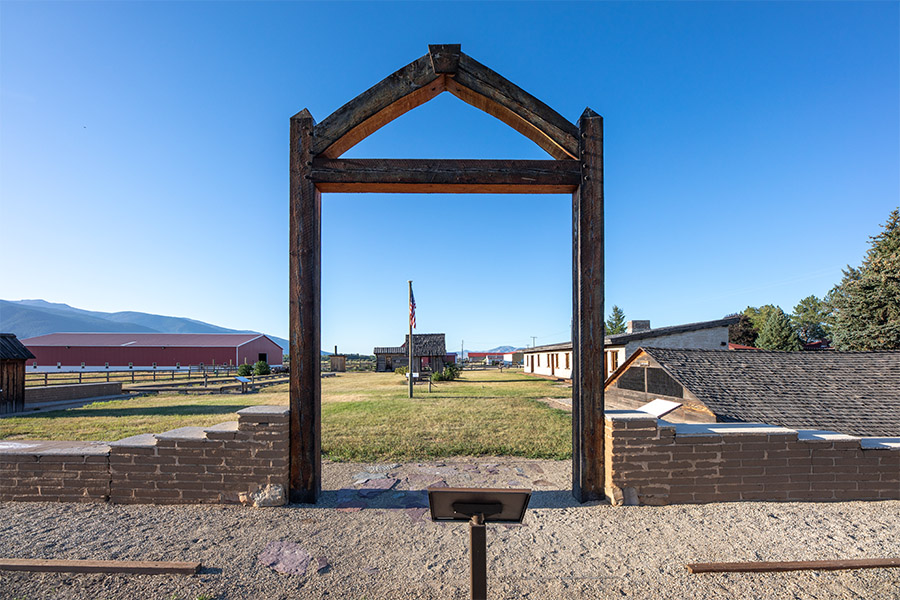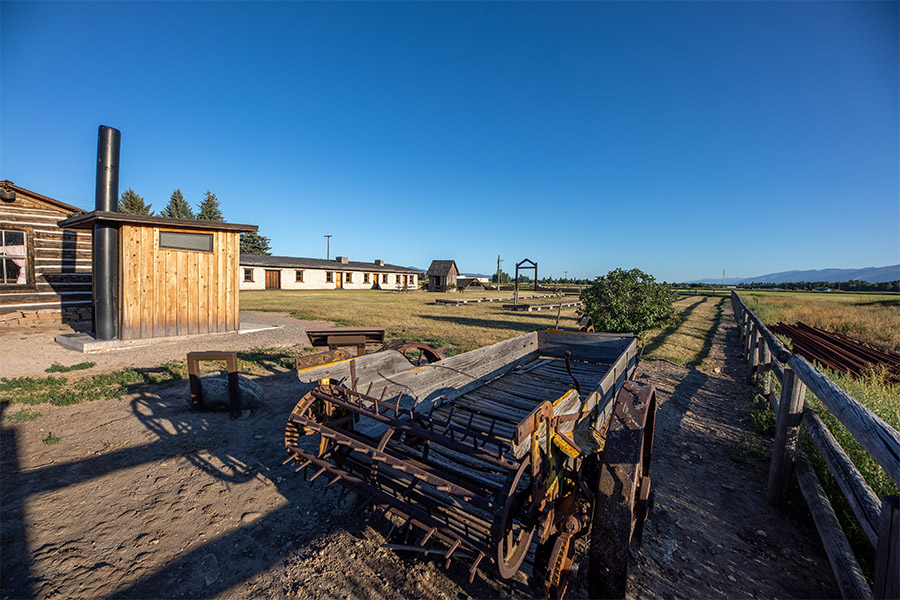Fort Owen: Where Montana’s Story Began – A Crucible of Cultures in the Bitterroot Valley
The Bitterroot Valley, nestled against the dramatic backdrop of the Rocky Mountains in western Montana, is a landscape of profound beauty and deep history. Here, where the Bitterroot River carves its path through verdant meadows and ponderosa pine forests, the foundations of what would become the Treasure State were first laid. It wasn’t with a gold rush, nor with a grand military expedition, but with a humble mission and later, a bustling trading post that Montana truly began to coalesce into a recognizable frontier society. That place was Fort Owen, a site whose weathered timbers and reconstructed walls whisper tales of ambition, diplomacy, commerce, and conflict, serving as a crucible where Indigenous life, Jesuit idealism, and American enterprise converged and clashed.
Today, Fort Owen State Park near Stevensville offers a glimpse into this foundational past. But to truly understand its significance, one must peel back the layers of time, tracing its evolution from a spiritual haven to a commercial hub, and finally, to a poignant symbol of a bygone era.
The Genesis: St. Mary’s Mission and the Black Robes

The story of Fort Owen doesn’t begin with a military major, but with a Jesuit priest and the request of a determined people. In the early 1830s, the Salish (Flathead) people, weary of relentless raids by their traditional enemies, the Blackfeet, and intrigued by the spiritual power they observed in Christian traders, sent several delegations eastward. Their pleas for "black robes" – Jesuit priests – eventually reached Father Pierre-Jean De Smet, a Belgian missionary.
In 1841, De Smet, accompanied by Father Nicolas Point and Brother Charles Huet, arrived in the Bitterroot Valley. With the blessing of the Salish, they established St. Mary’s Mission near the present-day town of Stevensville, making it the first permanent Catholic mission and the first permanent white settlement in what would become Montana. The mission was more than just a church; it was an ambitious experiment in cultural exchange. The Jesuits introduced farming techniques, built a grist mill, a sawmill, and taught the Salish not only Christianity but also new methods of agriculture and construction.
Among the early Jesuits was the remarkable Father Antonio Ravalli, an Italian priest and polymath. Ravalli was a physician, an architect, a sculptor, and a painter, all rolled into one. He tended to the sick and injured, both Native and white, designed and built structures, and crafted exquisite religious art. His medical skills were particularly prized, earning him respect and gratitude across the vast frontier. As historian Robert Bigart noted, "Ravalli was a man of extraordinary talents, a physician, an architect, a sculptor, and a painter, all rolled into one, whose compassionate work deeply impacted the Salish people."
However, the mission faced insurmountable challenges. The Blackfeet threat persisted, making settled life precarious. The Salish found it difficult to abandon their nomadic hunting traditions entirely, and the introduction of European diseases took a devastating toll. Most critically, the arrival of white traders, often bringing whiskey, undermined the Jesuits’ efforts to instill temperance and order. By 1850, recognizing the futility of their mission in the face of these pressures, the Jesuits temporarily abandoned St. Mary’s, selling its assets to an ambitious entrepreneur who would reshape its destiny.
Major Owen’s Domain: From Mission to Trading Post
That entrepreneur was Major John Owen. A former sutler (a civilian provisioner) for the U.S. Army at Fort Hall in present-day Idaho, Owen was a man of vision, determination, and a keen eye for opportunity. He saw the strategic location of the abandoned mission – a natural crossroads for Native trails, nascent settler routes, and the potential for a burgeoning fur and provision trade. In 1850, he purchased the mission property for the sum of $250 and a few pack animals.
Owen immediately set about transforming the mission into a fortified trading post, which he named Fort Owen. He reinforced the existing log structures, enclosed them with a formidable 12-foot-high stockade of cottonwood logs, and added two bastions at opposite corners for defense. Within its walls, he built a general store, living quarters, a blacksmith shop, and storage facilities. Fort Owen quickly became the most significant commercial enterprise and social hub in the entire Montana territory for the next two decades.
"It was a veritable oasis in the wilderness," observed one contemporary traveler, marveling at the scale and organization of Owen’s enterprise. The fort became a magnet for a diverse array of individuals: Salish and Kootenai people bringing furs, trappers and mountain men seeking supplies, prospectors dreaming of gold, U.S. Army detachments on reconnaissance, and pioneering families venturing westward. Owen, with his pragmatic approach and often gruff but fair demeanor, navigated this complex human tapestry.

The Apex of Frontier Life: Commerce, Diplomacy, and Conflict
Under Owen’s proprietorship, Fort Owen flourished. It was more than just a trading post; it was a nexus of frontier life. Owen bartered for beaver pelts, buffalo robes, and other furs from Native Americans, offering in return manufactured goods like blankets, tools, coffee, sugar, and flour. He supplied military expeditions, including those of Captain John Mullan, who surveyed and built the famous Mullan Road connecting Fort Benton to Walla Walla, Washington. The fort also provisioned the early gold miners who flocked to Montana in the 1860s, making it an essential link in the supply chain for the burgeoning mining camps of Bannack and Virginia City.
Owen was also an innovator. Recognizing the need for local production, he rebuilt and improved the grist mill originally started by the Jesuits, making it the first fully operational grist mill in Montana. He also operated the first sawmill, providing lumber for the fort and early settlers. These "firsts" underscored Fort Owen’s role as a true cradle of civilization in the region.
The fort also served as an unofficial diplomatic center. Owen, fluent in several Native languages and possessing a deep understanding of Indigenous cultures, often mediated disputes and facilitated communication between various tribes and the encroaching white world. Governor Isaac Stevens, during his epic survey for a transcontinental railroad route in 1853-55, made Fort Owen a crucial stop, holding councils with tribal leaders and relying on Owen’s knowledge and influence. These interactions, while often peaceful, also hinted at the growing pressures on Native lands and sovereignty.
Yet, Fort Owen’s golden age was not without its shadows. The whiskey trade, a destructive force on the frontier, was a constant struggle. While Owen understood the perils of alcohol, he also recognized its commercial value and the demands of his clientele, often Native Americans who had developed a taste for it. He wrestled with the morality and practicality of selling liquor, a commodity that brought both profit and immense social harm. "The whiskey trade was a scourge upon the land," many contemporary observers noted, "corrupting both red and white, and Owen himself could not entirely escape its grasp." The fort, while a beacon of commerce, also became a place where the devastating effects of cultural collision were starkly evident.
Decline and Departure: The Fading Light of an Empire
By the late 1860s, Fort Owen’s prominence began to wane. The fur trade, its initial economic engine, was in decline as beaver populations dwindled and fashions changed. The focus of Montana’s economy shifted eastward to the gold fields and then to cattle ranching. Newer, more accessible settlements and supply routes emerged, bypassing the Bitterroot Valley.
Owen himself also faced personal struggles. Years of frontier life, the constant demands of his business, and a growing dependence on alcohol began to take their toll on his health and mental state. His once-sharp business acumen faltered, and his finances deteriorated. The dream of a lasting empire in the Bitterroot began to unravel.
In 1872, after more than two decades at the helm, a broken and financially ruined John Owen sold Fort Owen. He left the valley, eventually succumbing to his ailments in a mental institution in Maryland in 1889. His departure marked the end of an era for Fort Owen and for the Bitterroot Valley.
From Ruin to Remembrance: The Enduring Legacy
After Owen’s departure, the fort slowly fell into disrepair. Its sturdy log walls and buildings, no longer maintained, began to crumble. Settlers in the valley, seeing a ready source of timber, dismantled parts of the stockade and buildings for their own construction projects. By the turn of the 20th century, little remained of the once-bustling post save for a few dilapidated structures and the faint outlines of its former grandeur.
However, the memory of Fort Owen persisted. Local residents and historians recognized its immense importance as the site of Montana’s first permanent white settlement and a pivotal point in its early development. In the mid-20th century, efforts began to preserve what was left and interpret its history. In 1937, the site became a state park. Over the decades, archaeological excavations and dedicated preservation work have brought parts of Fort Owen back to life. The surviving log structure, believed to be the original guardhouse, stands as a testament to its past. Reconstructed walls, a bastion, and interpretive signs now help visitors visualize the fort’s layout and understand its complex story.
Today, Fort Owen State Park serves as a tangible link to Montana’s earliest chapters. It is a place where one can walk the grounds where Salish, Jesuits, fur traders, soldiers, and settlers once mingled, traded, and struggled. It reminds us that Montana’s history is not just about rugged individualism, but also about the intricate interplay of different cultures, the ambitious dreams of pioneers, and the profound, often challenging, impact of westward expansion on Indigenous peoples.
Fort Owen wasn’t just bricks and mortar; it was the crucible where Montana’s complex identity was forged. It stands as a silent sentinel in the beautiful Bitterroot Valley, a powerful reminder of the diverse forces that shaped the state, and a testament to the enduring human story that unfolded on this significant patch of ground. Its echoes continue to resonate, inviting us to reflect on the foundations of our past and the legacies that continue to shape our present.


